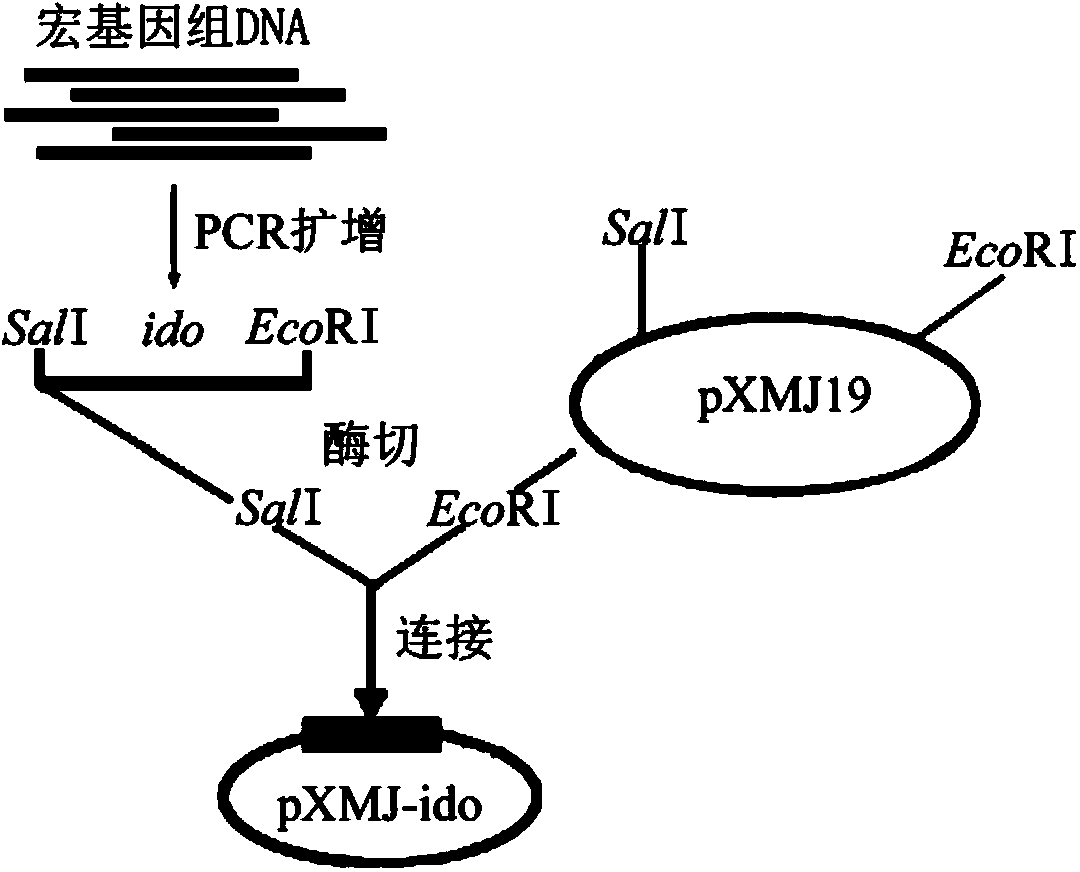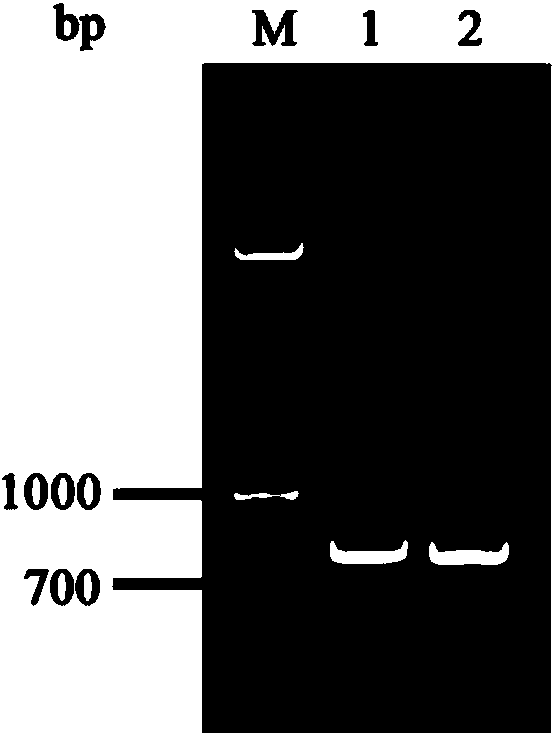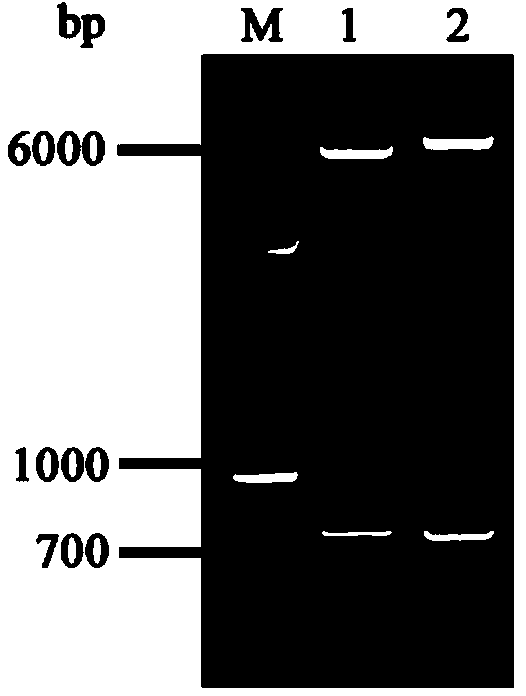L-isoleucine hydroxylase gene as well as genetically engineered bacterium and application of L-isoleucine hydroxylase gene
A technology encoding isoleucine hydroxylase and isoleucine hydroxylase is applied in genetic engineering, application, oxidoreductase and other directions, can solve problems such as limited gene sequence, achieve low cost, reduce production cost, Simple and feasible effect
- Summary
- Abstract
- Description
- Claims
- Application Information
AI Technical Summary
Problems solved by technology
Method used
Image
Examples
Embodiment 1
[0050] Example 1: Acquisition of the gene ido encoding L-isoleucine hydroxylase
[0051] The soil metagenome was extracted using the following methods:
[0052] Take 10g soil samples at 10cm below the topsoil in the garden of Tianjin University of Science and Technology and place them in a shaker flask, add 20mL DNA extraction solution (100mol / L Tris-HCl, 100mmol / L EDTA2Na; 100mmol / L Na3PO4, 1.5mol / L NaCl, 2% CTAB, pH8.0) and mix well. Add 500 μL of lysozyme (50 mg / mL, pH 8.0), mix well and then bathe in water at 37°C for 30 min. After being placed in an ultrasonic cleaner for 10 minutes, 1.5 g of sterile glass beads (diameter 1 mm) were added and shaken for 5 minutes. Add 40 μL of proteinase K (20 mg / mL), mix well, then add 2 mL of 20% SDS, bathe in water at 65 °C for 1 h, and shake gently every 15-20 min. Centrifuge at 10000 g for 10 min at room temperature, collect the supernatant and transfer to another centrifuge tube. Extract once each with equal volumes of phenol an...
Embodiment 2
[0059] Example 2: Construction of the recombinant plasmid pET-ido and functional analysis of the gene ido encoding L-isoleucine hydroxylase
[0060] The recombinant plasmid containing ido-3 was extracted and digested with restriction endonucleases NdeI and XhoI, followed by agarose electrophoresis, recovered after gel cutting, and connected to the expression vector pET-42a that had been cut with the same enzymes to obtain the recombinant plasmid pET-ido. It was transformed into E.coli BL21 (DE3) competent cells to obtain the recombinant strain BL-IDO.
[0061] The BL-IDO seed culture was inoculated into LB liquid medium, and 0.1mmol / L IPTG was used to induce expression for 4h. Take 1 mL of the culture and centrifuge at 10,000 g for 1 min at 4°C to collect the bacteria, and wash with 1 mL of buffer A (Na 2 HPO 4 12H 2 O2.9g / L, NaCl8.5g / L, NaH 2 PO 4 2H 2 (00.30g / L, pH7.4) Wash the bacterial pellet 3 times and resuspend with 1mL buffer A. Ultrasonic disrupt the above bact...
Embodiment 3
[0065] Embodiment 3: Construction of recombinant plasmid pXMJ-ido and recombinant strain CG-ido (see the construction process figure 1 )
[0066] Using the recombinant plasmid pET-ido as a template, use primers IDO-3 and IDO-4 to amplify its ido gene (see the electrophoretic pattern of the ido gene PCR product figure 2 );
[0067] IDO-3: 5'-CCG GTC GAC AAGGAAGCTAGATATGAAAATGAGTGGCTTTAGCATAG-3'(Sal Ⅰ)
[0068] IDO-4: 5'-CCG GAATTC TTATTTTGTCTCCTTATAAGAAAATGTTACTA-3'(EcoR Ⅰ)
[0069] The PCR conditions were: 94°C for 5 min for 1 cycle, 94°C for 30 s, 56°C for 30 s, 72°C for 1 min and 30 cycles, 72°C for 10 min and 1 cycle, and the reaction system was 100 μL. 10 μL of PCR products were detected by 1.5% agarose gel electrophoresis.
[0070]After recovery, the remaining 90 μL of the PCR amplification product was digested by SalⅠ and EcoRI respectively, and after being recovered by electrophoresis and gel cutting, it was connected to the expression vector pXMJ19 to obtain t...
PUM
| Property | Measurement | Unit |
|---|---|---|
| diameter | aaaaa | aaaaa |
| molecular weight | aaaaa | aaaaa |
| conversion efficiency | aaaaa | aaaaa |
Abstract
Description
Claims
Application Information
 Login to View More
Login to View More - R&D
- Intellectual Property
- Life Sciences
- Materials
- Tech Scout
- Unparalleled Data Quality
- Higher Quality Content
- 60% Fewer Hallucinations
Browse by: Latest US Patents, China's latest patents, Technical Efficacy Thesaurus, Application Domain, Technology Topic, Popular Technical Reports.
© 2025 PatSnap. All rights reserved.Legal|Privacy policy|Modern Slavery Act Transparency Statement|Sitemap|About US| Contact US: help@patsnap.com



